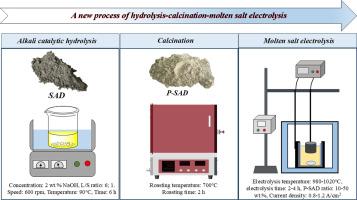采用高温电化学还原法从二次铝渣中同时萃取Al、Fe、Si制备铝基中间合金
IF 10.9
1区 环境科学与生态学
Q1 ENGINEERING, ENVIRONMENTAL
引用次数: 0
摘要
采用水解煅烧与熔盐电解相结合的短流程工艺,从二次铝渣中回收铝、硅、铁。热力学和表征研究阐明了预处理过程中的反应途径、相变,以及预处理后的SAD (P-SAD)在冰晶石熔盐中的溶解行为、电解机理和元素迁移(Al、Si、Fe),克服了其溶解度差的缺点。研究结果表明,Al2O3的存在可以促进Si元素的回收,优化电解(30 wt.% P-SAD, 1000℃,1 A/cm2, 3 h)可制得含Si 1.2 wt.%和Fe 0.9 wt.%的铝合金,电流效率为76.7%。显微组织分析表明,Al基体具有Al-Si和Al-Si-Fe金属间相,Si分布均匀,Fe局部富集。该研究为高价值SAD利用的电解回收过程提供了系统的见解。本文章由计算机程序翻译,如有差异,请以英文原文为准。

Simultaneous extraction of Al, Fe, Si to prepare aluminum-based intermediate alloys from secondary aluminum dross by a high temperature electrochemical reduction method
A short-process technology integrating hydrolysis-calcination and molten salt electrolysis was developed to recover Al, Si, and Fe from secondary aluminum dross (SAD). Thermodynamic and characterization studies elucidated the reaction pathways, phase transformations during pretreatment, and the dissolution behavior, electrolytic mechanism, and element migration (Al, Si, Fe) of pretreated SAD (P-SAD) in cryolite molten salts, overcoming its poor solubility. The research results show that the presence of Al2O3 can promote the recovery of the Si element, and optimized electrolysis (30 wt.% P-SAD, 1000 °C, 1 A/cm2, 3 h) produced an Al-alloy containing 1.2 wt. % Si and 0.9 wt. % Fe with 76.7 % current efficiency. Microstructural analysis showed an Al matrix with Al-Si and Al-Si-Fe intermetallic phases, exhibiting uniform Si distribution and localized Fe enrichment. This study provides systematic insights into the electrolytic recovery process for high-value SAD utilization.
求助全文
通过发布文献求助,成功后即可免费获取论文全文。
去求助
来源期刊

Resources Conservation and Recycling
环境科学-工程:环境
CiteScore
22.90
自引率
6.10%
发文量
625
审稿时长
23 days
期刊介绍:
The journal Resources, Conservation & Recycling welcomes contributions from research, which consider sustainable management and conservation of resources. The journal prioritizes understanding the transformation processes crucial for transitioning toward more sustainable production and consumption systems. It highlights technological, economic, institutional, and policy aspects related to specific resource management practices such as conservation, recycling, and resource substitution, as well as broader strategies like improving resource productivity and restructuring production and consumption patterns.
Contributions may address regional, national, or international scales and can range from individual resources or technologies to entire sectors or systems. Authors are encouraged to explore scientific and methodological issues alongside practical, environmental, and economic implications. However, manuscripts focusing solely on laboratory experiments without discussing their broader implications will not be considered for publication in the journal.
 求助内容:
求助内容: 应助结果提醒方式:
应助结果提醒方式:


